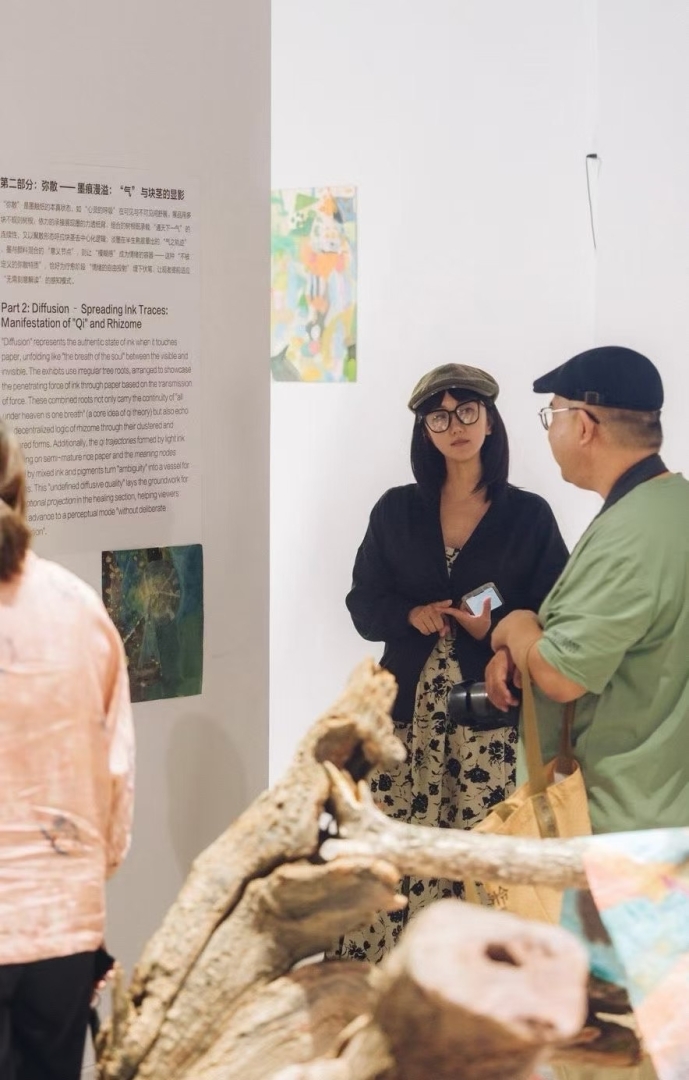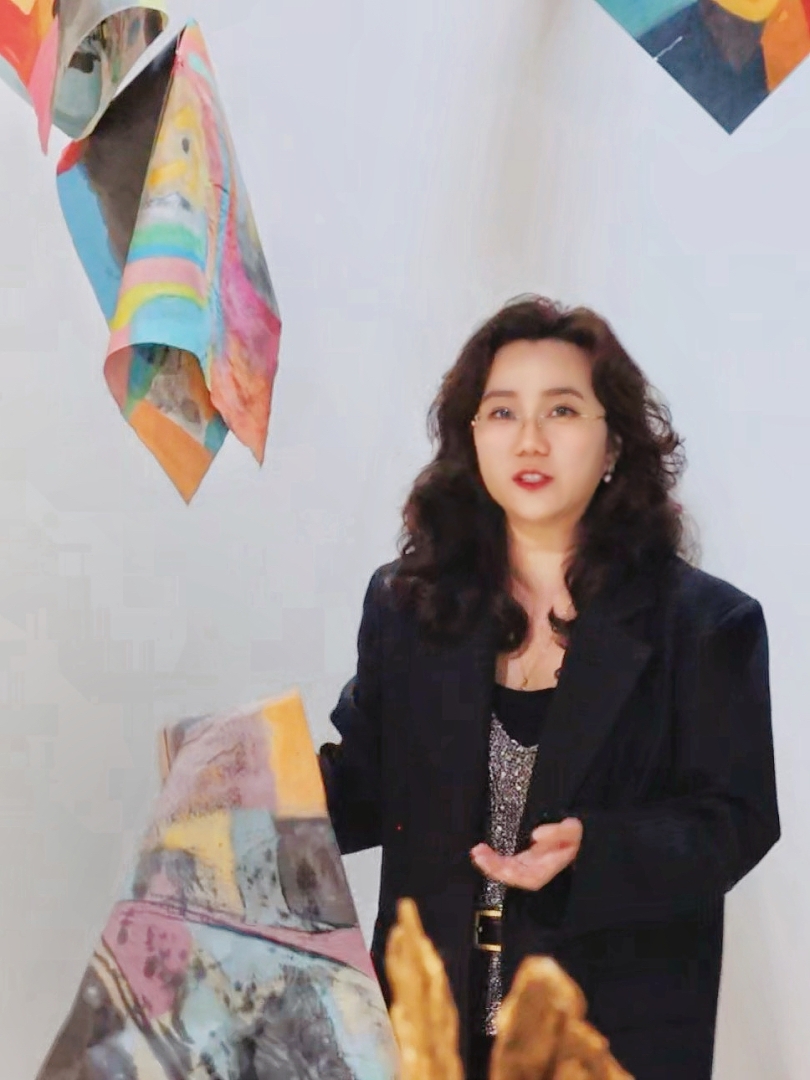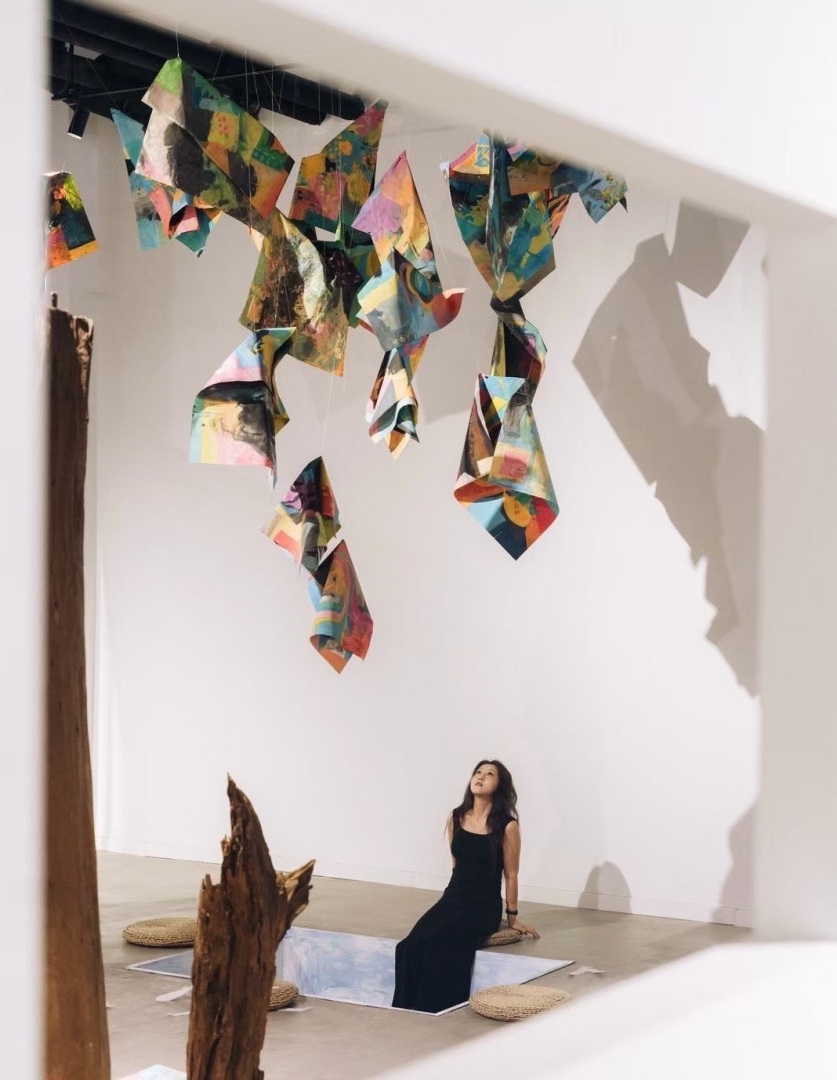


TAIYUAN, China – In a quiet gallery on Kai Xuan Street, ink breathes, water ripples, and emotions take form in “Diffusion and Flow — A Grammar of Healing.” The exhibition, on view from September 14 to 21 at In Gallery, brings together the delicate spontaneity of ink with the reflective calm of healing. At its center stands artist Xie Wenli, whose works turn traditional Chinese ink into a medium of emotional resonance, guided by the curatorial visions of Ning Xizhen, Wang Nan, and Wei Wei.
For lead curator Ning Xizhen, a postgraduate at the Royal College of Art in London and Xie’s daughter, the exhibition is both an act of artistic collaboration and a personal tribute. “This is not just about my mother’s art,” she said. “It’s about the power of art itself to heal, to reconnect, and to remind us of what it means to be alive.”
Ning, who also studied art therapy at the University of Florida, approaches curation as emotional architecture — guiding viewers through a sensory grammar of diffusion, flow, and healing. “Diffusion,” she explains, “is the dissolution of boundaries — like scent in air or ink in water.” Her vision transforms the exhibition into a living field where paintings, installations, and soundscapes dissolve the traditional line between artwork and viewer. “Flow,” she continues, “is the natural state of being. Through ink and movement, we remind ourselves that change is not chaos but regeneration.”
Under Ning’s direction, “Diffusion and Flow” unfolds as a spatial journey: from the rhythmic movement of brushstrokes to the quiet expansion of ink traces, culminating in a collective space of resonance. For her, healing is not a cure but a process — “a way of rewriting emotional syntax through art.”
The exhibition’s curatorial structure mirrors its title, arranged in three interlinked sections — Flow, Diffusion, and Healing — each revealing a different layer of Xie’s artistic language.
In “Flow — Surging Brushstrokes: Dynamic Generation Between Tradition and Contemporaneity,” long scrolls and red-toned installations break the static boundaries of traditional display. Ink spreads and contracts in rhythm with the artist’s gestures, creating a living choreography between tradition and modernity. Viewers are invited to walk along the exhibition path, becoming participants in the movement of ink and air — no longer passive observers but part of the flow itself.
The second section, “Diffusion — Spreading Ink Traces: Manifestation of Qi and Rhizome,” introduces irregular tree roots as sculptural anchors. These roots, ink-stained and intertwined, evoke both qi — the continuous life force described in Zhuangzi — and the decentralized networks of Deleuze and Guattari’s rhizome theory. Here, ink’s uncertain edges embody emotional ambiguity, inviting viewers to embrace unformed feelings. “Ambiguity itself becomes a vessel for emotion,” said co-curator Wang Nan. “Healing often begins when we allow things to be unfinished.”
The final section, “Healing — Resonance and Symbiosis: Self-Connection Amid Imperfection,” turns reflection into participation. Small-scale rice paper works are suspended at sitting height, surrounded by the scent of aged ink and the tactile presence of paper fibers. An interactive area titled “Ink Heart, Self-Dyed” invites visitors to crumple paper and stain it with ink — a symbolic act of release. In these imperfect marks, the curators suggest, lies the possibility of acceptance.
Co-curator Wang Nan, who holds a master’s degree in art and design education from University College London and is a certified psychological counselor, grounds the exhibition’s emotional dimension in both theory and empathy. Her curatorial design emphasizes psychological rhythm — leading the audience from movement to stillness, from outward exploration to inward connection.
“Every arrangement, every sequence in space is intentional,” Wang said. “The first section encourages movement and participation, the second opens room for ambiguity, and the final one brings you back to stillness — to listen to your own breathing. The process itself mirrors emotional healing.”
Wang’s approach to “art as relationship” bridges psychology and aesthetics. She sees each artwork not as an object to be decoded, but as a relational field where viewers and materials meet. “In the end,” she added, “the ink’s diffusion is our own — our emotions spreading, softening, and finding form.”
A third co-curator, Wei Wei, contributes an academic and transnational lens to the project. Currently pursuing a master’s degree in art and design in Thailand with a focus on calligraphy and painting, she helped integrate traditional artistic forms with contemporary social dialogue. Her contribution ensures the exhibition’s balance between scholarly rigor and accessibility. “Art,” she noted, “is more than visual — it’s a dialogue that transcends language and culture.”
Xie Wenli, often described as a “female force in art,” brings together the tranquility of ink with the emotional intensity of post-impressionist expression. Her works — displayed on walls, bamboo weaves, tree branches, and suspended wires — embody both fragility and strength. The settings themselves become metaphors for life’s uneven rhythms: delicate, grounded, and constantly shifting.
Through Xie’s brush, ink becomes both material and metaphor — capturing the pulse of life as it diffuses, flows, and heals. Her artistic philosophy draws from Eastern meditation and Western psychology, turning painting into a meditative practice of release and renewal. In one installation, moon-like ink circles hang suspended, evoking the balance between imperfection and serenity. As Ning described, “Each moon is a reminder that even fragments can reflect light.”
In Gallery director Liu Xin described the exhibition as “one of the most special” in the institution’s history. “It’s not only Xie Wenli’s art that moved me,” Liu said. “It’s the sincerity and care of her curators — especially her daughter — that makes this exhibition an act of love as much as art.” Comparing Xie’s resilience to that of Frida Kahlo, Liu added, “Before being an artist, one must first be a thinker.”
Ultimately, “Diffusion and Flow — A Grammar of Healing” invites viewers to reconsider what art can do beyond aesthetics — how it can hold, soothe, and reorient us in a fragmented world. Through ink’s quiet diffusion and the curators’ sensitive orchestration, the exhibition becomes a living grammar of care: a space where emotion, philosophy, and art merge in one continuous breath.
(Written by Jessie Epstein)
Media Contact
Company Name: Emergent Digital
Contact Person: Jessie Epstein
Email: Send Email
Country: United States
Website: emergentpr.com
